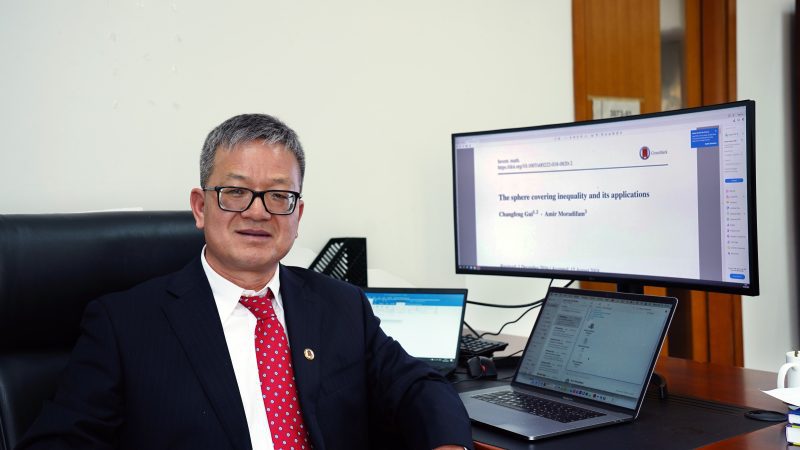Interview with Prof Changfeng GUI of FST – The story of well-known scholar in the field of partial differential equations
專訪科技學院桂長峰教授 – 偏微分方程學者的故事


桂教授分享多年來研究數學的心得 Prof Gui shared his insights on studying Mathematics

桂教授給莘莘學子的不少實用的建議 Prof Gui gave students many useful advises
Prof Changfeng Gui joined the University of Macau (UM) in 2023 as the Chair Professor and the Head of the Department of Mathematics in the Faculty of Science and Technology (FST). He received his undergraduate and master’s degrees from Peking University and earned a PhD degree in Mathematics from the University of Minnesota in 1991. Prof Gui is currently a fellow of the American Mathematical Society (AMS) and has received several remarkable awards, including the Research Achievement Award of the Pacific Institute for the Mathematical Sciences (PIMS); the André Aisenstadt Prize in Mathematics from the Centre de Recherches Mathématiques; IEEE Best Paper Award, and the Overseas Cooperation Fund of the National Natural Science Foundation of China (NSFC). His main research interests are nonlinear partial differential equations, applied mathematics, and image analysis and processing. Prof Gui believes that partial differential equations are an essential branch of mathematics and a critical tool in many engineering and scientific fields, such as mechanical engineering and geophysics.
How to study partial differential equations
Partial differential equations are widely used to describe changes and movements in physical phenomena. Prof Gui shared the example of the rate of change of a phenomenon, which is itself a differential, and explained that the study of such phenomena unavoidably involves partial differential equations. Many physical problems remain unsolved, and the solutions to most problems cannot be clearly indicated in formulas. Prof Gui explained that typically there are two methods for studying the corresponding partial differential equations of these problems: one is to study some qualitative characteristics of the problem, such as its symmetry, monotonicity, and asymptotic expansion, even if it is difficult to clearly exhibit the solution of the problem in formulas; the other is to calculate the numerical solution of the equation and study the theoretical problems related to the numerical solution, such as whether there is a reasonable numerical solution and whether the solution is accurate. The study of partial differential equations is therefore very important.
The reasons for choosing this research direction
Prof Gui chose partial differential equations as his research direction due to his passion for mathematical analysis. He shared that he particularly enjoyed the course of mathematical analysis during his undergraduate studies, which included courses requiring a deeper understanding than calculus, such as real analysis and functional analysis. This further sparked his enthusiasm for the “analysis” branch in Mathematics, and the core method of partial differential equations is “analysis”, which integrates ideas from other branches of Mathematics such as geometry and topology and occupies a central position in the field of mathematics. During his doctoral studies in the United States, Prof Gui had more opportunities to interact with renowned scholars in this field. “Because I had interactions with these masters during my studies, I naturally focused on partial differential equations as my research direction.” Currently, Professor Gui’s research focuses mainly on the theory of nonlinear partial differential equations, which includes two special directions: one is the study of a class of best inequalities closely related to physics and geometry, especially on high-dimensional spheres; and the other is a special type of nonlinear equation related to phase transitions in material science, which has important theoretical and practical applications and has been a problem that Prof Gui has been studying for many years. In terms of the application of partial differential equations, Prof Gui focuses on the application of Mathematics in image processing. By designing well-functioning algorithms and utilizing computer processing, he hopes to solve problems in medical imaging and scientific detection while also establishing a solid mathematical theory.
The reasons for choosing the UM
Regarding his decision to join UM, Prof Gui expressed his desire to return to China to further participate in Mathematics teaching and research. “UM provides me with the opportunity to continue my research in a new and dynamic environment with highly motivated students.” He says. As the Head of the Department of Mathematics, Prof Gui hopes that his joining will help to further enhance the research level and atmosphere of the entire mathematics department and lead the department to achieve more and better mathematical results.
Useful advices for students
Regarding young students who interested in pursuing Mathematics research, Prof Gui advises, “It is crucial to establish a solid foundation in Mathematics, while not limit yourself to a narrow field. Student needs to explore and understand various branches of Mathematics.” Regarding Mathematics research, Prof Gui hopes that students should not be too hasty in seeking results after conducting the research projects and should not rush in papers publication. They would not be able to explore the potential of Mathematics or the joy and satisfaction of learning, and they would lose the motivation to study Mathematics if they only pursue the quantity of papers and ignore the pursuit of quality. Prof Gui also suggested that as a student of Mathematics, it is necessary to possess a strong foundation in fundamental mathematical knowledge and techniques, as well as adopting a multidimensional approach to problem-solving and seek out methods for resolving mathematical difficulties. Regardless of focusing on Applied or Theoretical Mathematics, it is only through the cultivation of these skills that student can achieve fruitful results in mathematical research.
桂長峰教授於2023年加入澳門大學,現為科技學院數學系系主任及講座教授。他本科及碩士畢業於北京大學,並於1991年獲美國明尼蘇達大學數學博士學位,自此踏上收穫豐碩的研究之路。作為一位知名數學家,除了目前是美國數學會會士 (AMS Fellow),桂教授過去曾獲多項重要獎項,包括加拿大太平洋數學研究所研究成果獎、加拿大蒙特利尔数学研究中心Aisensdadt 獎、IEEE 最佳論文獎、中國國家自然科學基金海外合作基金(海外傑青)等。他主要的研究領域為非線性偏微分方程、應用數學及圖像分析與處理。
偏微分方程的研究
桂教授表示偏微分方程是數學的核心分支,也是眾多工程和科學領域的重要工具,如機械工程、地球物理學等。偏微分方程被廣泛應用於描述物理現象中的變化和運動。桂教授以事物變化速度為例,指出其本身是一種微分,若要對其進行研究,不可避免會用到偏微分方程。物理問題中有很多未解的問題,多數問題的解決方法沒辦法簡單地用公式清晰展示。桂教授表示通常有兩個方法對這些問題對應的偏微分方程進行研究,其一是研究問題的一些定性特徵,既使難以用公式明確把問題的解展示出來,但仍可研究其對稱性、單調性、漸進展開等各項定性的性質;另一個方法則是計算方程的數值解、研究數值解方面的理論問題,有無合理的數值解及解是否準確的問題。偏微分方程的研究因此會非常重要。
選擇偏微分方程作爲研究方向的原因
談及爲何選擇偏微分方程作爲其研究方向,桂教授分享大學時非常喜歡數學分析這門課,而數學更包括一些比微積分更需深刻理解的課程,如實變函數,泛函分析,這更激發桂教授的對數學中“分析“這個分支的熱誠, 而偏微分方程的核心方法是“分析”, 且融合了 ”幾何“, ”拓撲“ 等數學的其他分支的思想,在數學領域也處於核心地位。 桂教授在美國攻讀博士學位期間,有更多機會接觸到此領域久負盛名的學者。他說:「因為學習期間與這些大師有更多交集,很自然的更想將偏微分方程作爲目標。」目前桂教授的研究方向主要是非線性偏微分方程的理論,其中包含兩個特別的方向: 一個是與物理和幾何有密切關係的一類最佳不等式的研究,特別是在球面上,包括高維球面。 以及這類數學不等式物理上的背景與應用。 研究這類不等式最終關鍵的問題也會落實到一個非綫性偏微分方程,而對這個偏微分方程解的性質的研究,特別是唯一性的研究至關重要;另一個方向則是一類與材料科學裡相變有關的一類特殊的非線性方程,這個方向的研究在數學理論和具體應用上都會產生深遠影響,也有桂教授研究多年來希望解決的重要問題。在偏微分方程的應用上,桂教授把重點放在數學在圖像處理中的應用,通過設計好的算法利用計算機對相關圖像的處理,解決醫學圖像及科學探測中的問題,同時也建立堅實的相關數學理論。
選擇澳大的理由
問及選擇澳大的原因,桂教授表示,在美國取得博士學位後,先後在美國及加拿大研究了三十多年數學,期間與中國的數學界有很多交流,每年都會到香港及內地進行數學的交流講學。「我很希望回到中國,更深入的參與數學教學和研究,正好澳大有這種機會給我,能夠在很新的一個學校、學生很有朝氣的一個地方繼續研究,所以我選擇了這裡。」桂教授在澳大也有自己的期望,「澳門大學是一個很有活力的大學。學生非常優秀,老師也有很高的追求。我希望在澳大,我能夠把我們研究方向變成有影響的成果,也培養出具有國際影響的研究團隊。」作為澳大數學系現任的系主任,桂教授希望他的加入,能夠幫助把整個數學系的研究條件和氣氛更提高一層,帶領數學系取得更多更好的數學成果。
給莘莘學子的建議
對於有志從事數學研究的年輕學生,桂教授語重心長地建議: 「讀數學一定要打好扎實的基礎,不要過於局限自己在一個狹隘的方向,需要更多接觸了解不同數學的分支。」對於數學研究,桂教授希望同學們切勿急功近利,在接觸專案後不要急於求成匆匆發表文章。 假若只重視論文數量而忽視對品質的追求,則無法深入挖掘數學的潛力和感受研究數學的樂趣,同時也會失去對數學的熱誠及動力。桂教授也表示:「作爲一個數學系的學生,一方面要扎實掌握數學基本知識及方法,另一個方面也要多角度思考,尋找如何解決數學疑難的方法,往後發展方向不論是鑽研應用數學或理論數學,始能在數學研究中獲得豐碩的成果。」